7 of 10
Sequence
The 7 of 10 concept was introduced on this newsletter on March
7, 2010 in Issue 175
and on March 28, 2010 in Issue
178. The Zetas have predicted that one or more of these
scenarios will occur before the end of 2010, but until this past
week have not stated which event could be anticipated
to come first. They have not sequenced them. Previously, the had
described the folding of the Mariana Trench against the
Philippine Plate, which likewise will tilt and fold against
Indonesia. This area of the Ring of Fire will be folding like a
deck of playing cards being swept up and gathered up off a table
top.
ZetaTalk Prediction
8/21/2010: It is the pressure from the
Pacific that is the issue, as the Pacific is compressing.
Likewise, the Philippine Plate is at issue, as it loses in the
compression game and in essence is pushed under and lost. The
Philippine Plate is tipping, rising at the Mariana Islands and
diving under the tongue of the Eurasian Plate that holds
Indonesia. This tongue is itself being pushed down. Imagine
the domino effect of the Mariana Trench folding against the
Philippine Plate, tipping this sideways to drive the western
edge under the tongue holding Indonesia, which is at the same
time breaking and bending to subduct under the curve of the
Indo-Australian Plate.
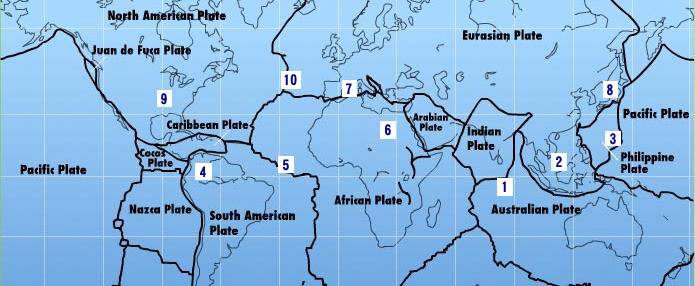
The Zeta sequence is as follows:
(1) a tipping Indo-Australia Plate with (2) Indonesia sinking,
(3) a folding Pacific allowing (4) S America to roll,
(5) a tearing of the south Atlantic Rift allowing (6) Africa to
roll and (7) the floor of the Mediterranean to drop,
(8) great quakes in Japan followed by (9) the New Madrid
adjustment,
(10) which is followed almost instantly by the tearing of the
north Atlantic Rift with consequent European tsunami.
ZetaTalk Prediction
10/16/2010: The 7 of 10 scenarios describe
plate movements, and for this to occur something has to
release the deadlock, the current stalemate where the plates
are locked against each other. Once the deadlock is broken and
the plates start moving, sliding past each other, new points
where the plates are locked against each other develop, but
these are weaker locks than the one at present. The current
lock, as we have so often stated, is the Indo-Australian Plate
which is being driven under the Himalayans. This is no small
lock, as the height of the Himalayans attests. Nevertheless,
the activity in this region shows this likely to be the first
of the 7 of 10 scenarios to manifest. Bangladesh is sinking
and the Coral Sea is rising, showing the overall tipping of
the Indo-Australian Plate. Now Pakistan is sinking and not
draining its floods as it should, while Jakarta on the tongue
of Indonesia is also sinking rapidly, showing that the tilt
that will allow Indonesia to sink has already started.
Meanwhile, S America is showing signs of a roll to the west.
Explosions on islands just to the north of the S American
Plate occurred recently, on Bonaire and Trinidad-Tobago, and
the Andes are regularly being pummeled. There is a
relationship. As the Indo-Australia Plate lifts and slides,
this allows the Pacific plates to shift west, which allows S
America to shift west also. This is greatly increased by the
folding of the Mariana Trench and the Philippine Plate. But it
is the Indo-Australian Plate that gives way to incite change
in these other plates, and this is what is manifesting now to
those closely following the changes. Once the folding of the
Pacific has occurred, Japan has been destabilized. We are not
allowed to give a time frame for any of these plate movements,
but would point out that it is not until the North Island of
Japan experiences its strong quakes that a tsunami causing
sloshing near Victoria occurs. There are clues that the New
Madrid will be next.
Where the N American continent is under great stress, it has
not slipped because it is held in place on both sides. The
Pacific side holds due to subduction friction along the San
Andreas, and the Atlantic side holds due to the Atlantic
Rift's reluctance to rip open. What changes this dynamic? When
S America rolls, almost in step with the folding Pacific, it
tears the Atlantic Rift on the southern side. This allows
Africa freedom to move and it rolls too, dropping the
Mediterranean floor above Algeria. What is holding the N
American continent together has thus eased, so that when the
Japan adjustments are made, there is less holding the N
American continent in place than before, and the New Madrid
gives way. We are also not allowed to provide the time frame
between the Japan quakes and New Madrid. Other than the
relationship in time between the New Madrid and the European
tsunami, no time frame can be given. The sequence of events
is, thus:
- a tipping Indo-Australia Plate with Indonesia sinking,
- a folding Pacific allowing S America to roll,
- a tearing of the south Atlantic Rift allowing Africa to
roll and the floor of the Mediterranean to drop,
- great quakes in Japan followed by the New Madrid
adjustment,
- which is followed almost instantly by the tearing of the
north Atlantic Rift with consequent European tsunami.
S America Roll
In addition to the 7 of 10 sequence, the Zetas provided more
information on the overall effect of the S American roll on the
S American continent. Previously, the Zetas had described the
effect on the Caribbean.
ZetaTalk Prediction
3/27/2010: For those wondering what
islands will be at risk during any S America plate roll, we
suggest the following exercise. Establish the fault lines, the
borders of the two plates in question - S America Plate and
Caribbean Plate. Pin the S America Plate at the tip, but
spread the Atlantic apart so the top part of S America must
roll to the west. Clearly, this puts S America pushing over
the Nazca Plate to her west, which is occurring now and
causing quakes all up and down the Andes. For the Caribbean
Plate, which includes Pamana and Central American countries,
there is pressure where the Caribbean Plate loses when
encountering the larger and more solid S American Plate. The
damage to the Caribbean Plate is not just to those areas which
will be pushed under the gliding edge of the S American Plate,
but also to those areas which will be dragged along, and
ground up as the plate border is rubbed like sandpaper, an
abrasion. In addition, the Caribbean Plate will react to
pressure on one side by raising an edge on the opposite side.
And any associated fault line will likewise react. This is a
complicated matter, but suffice it to say that there will be
no islands in the Caribbean which will not be affected, nor
will the countries in Central America find themselves exempt.
The Zetas likewise described any tsunami in the Caribbean that
would accompany the S American roll.
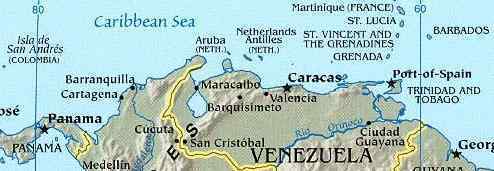
ZetaTalk Prediction
7/10/2010: Tsunami are generated anytime a
plate drops or rises under the sea. When the S American Plate
rolls, it will push the Caribbean Plate down, creating a void.
The void will primarily be at the southern part of the
Caribbean Plate, where islands will suddenly lose elevation,
some sinking entirely. This void will pull water from the
Caribbean as well as the Atlantic, which would seem to negate
the likelihood of a tsunami, but there will be a clash. When
the water rushes into the void it is water on the move, with
momentum, and this is the tsunami expected along the coastline
of Venezuela and its neighbors. This coastline will at first
find water receding, but this is a false signal and should not
be trusted. The wave will be coming. The islands will have no
such warning, but will sink suddenly in concert with the
quakes. In that the S American Plate reaches to the center of
the Atlantic, the rolling of the S American Plate will seem to
have scant impact on those coastlines facing the Atlantic.
There will be irregular tides, and certainly earthquakes, but
beyond a slight spreading of the Rio Parana river mouth at
Buenos Aires, which is ripping apart where the river empties
into the Atlantic, there will be little impact.
Are there signs that S America is preparing to roll? There are
many signs, but these are what the Zetas describe as precursors,
very minor in comparison to the actual event, which will occur
suddenly and carry with it an immense impact.
ZetaTalk Prediction
10/16/2010: Though there have been a lot
of precursor signs that S American is getting ready to roll-
an 8.8 quake along the Andes in Chile and exploding oil and
gas rigs in Bonaire and Trinidad-Tobago - these signs are but
the lightest touch compared to the actual event. We have
described tsunami that will occur in the Caribbean, and a
ripping open of the Rio Parana river mouth at Buenos Aires.
The primary effect of the S American roll will be on the small
islands in the Caribbean which ride just north of the S
America Plate border, as these will lose elevation suddenly,
and in some cases sink entirely. Will there be earthquakes?
Such movement of a plate does not occur silently. The entire
region, from the tip of S America to the islands on the north
border of the Carribean Plate will be jolted, and repeatedly,
during the roll. Along the Andes, these quakes will be in the
range of a magnitude 8-9, but lesser elsewhere. In that the
Andes will rise, riding over the Nazca Plate to the west, no
significant tsunami will be produced along the west coast of S
America. All major cities in the mountain building areas will
experience these great quakes - Santiago, La Paz, Lima, Quito,
and Bogota.
Those living along the border of S America and the hapless
Caribbean Plate will experience a great moaning and grinding
while the S American Plate glides over the Caribbean Plate,
pushing it down with its weight as it does so. Such a gliding
action does have catch points where the plates are not smooth,
and hesitation and jerking with a sudden release occurs, a
type of earthquake that seems to last for most of an hour.
Caracas as all of Venezuela will experience this seemingly
continuous quake, which will approach a magnitude 8 in
strength at times. As we have mentioned, the east coast of S
America just goes along for the ride. There will be
sympathetic jolts from the great quakes elsewhere on the
plate, but these will be relatively minor, at most a magnitude
7. When the seaway at Buenos Aires rips open, this is a silent
adjustment, as most stretch zone adjustments are. The
residents will recover from any earthquakes to see the far
shore of the seaway at a greater distance, and the mouth of
the Rio Parana widened.
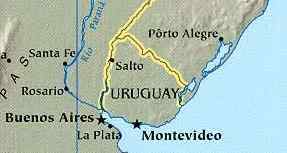
Seaway Rip
The Zetas have described the tearing of the St. Lawrence Seaway
as integral to the pending major adjustment along the New Madrid
Fault line. The N American continent is held, unmovable, at the
top. When the lower part of the N American continent pulls to
the west, at Mexico, more than adjustments up and down the
Mississippi occur. The Seaway will also adjust. How does this
relate to a massive heaving and renting open of the ground in
Menominee, MI recently?
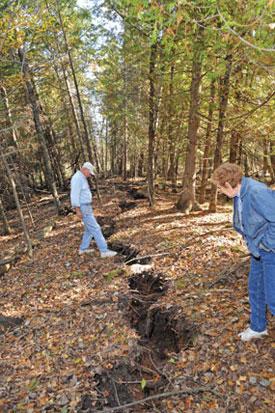
- Unexplained Crack Splits Up Backyard
October 5, 2010
http://www.fox11online.com/dpp/news/unexplained-crack-splits-mi-backyard
- A Michigan family's property has a
sudden unexplained divide. A large unexplained crack now
runs 200 yards through the Salewsky family's property,
eight miles north of Menominee in Birch Creek. The family
thinks it happened yesterday around 9:00 in the morning.
The ground raised five feet up, taking trees along for the
ride. Some cracks were up two feet wide and five feet
deep. There have been no recent reports of any earthquakes
in the area. People specializing in geological surveying
are being called in to try and explain the phenomenon.
-
- Large Crevice Confuses Residents
October 6, 2010
http://www.uppermichiganssource.com/news/story.aspx?id=522312
- One day the land was flat and
filled with trees shooting straight into the air.
Twenty-four hours later there's a 600-foot-long crack,
4-feet deep twisting its way through the woods - and those
vertical trees are now pointed 30 degrees left and right
where the earth has mounded 15 feet high.
The New Madrid Fault line in fact runs up along the Seaway.
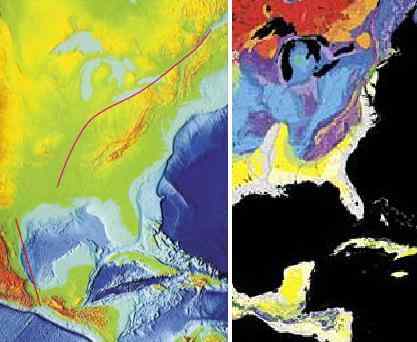
ZetaTalk Comment
9/25/2010: It is known by man that the New
Madrid Fault line runs beyond the immediate area of New
Madrid. Rock detached from its former connections is free to
react to the dominant theme in the area. If rock was held
down, formerly, it can bounce up. If rock was held back, it is
free to spring forward. And adjustment in rock strata means
that loose soil will sink or heave. This most certainly can
affect a broader area than just the fault line.
Per the Zetas, the effect of the tearing Seaway affects all the
lands from the mouth of the St Lawrence Seaway to the Black
Hills of South Dakota.
ZetaTalk Prediction
2/10/2006: The stress on the N American
plate will resolve by ripping the St. Lawrence Seaway open. A
widening Seaway also does not affect just those land masses
bordering the Seaway, as buckling occurs inland and afar. What
does man assume caused the Black Hills to be so rumpled, with
the appearance of a recent buckling and heaving? This is the
center of a land plate! The tearing of the Seaway does not end
at Duluth, MN. It travels underground to South Dakota!
On August 2, 2007 the bridge over the Mississippi River at
Minneapolis, MN snapped, flinging the south end of the bridge 50
feet to the east as it did so, as detailed in Issue 35 of this newsletter. Clearly, this
bridge was being twisted! Then on November 29, 2007 a pipeline
near Duluth, MN at Clearbrook ruptured, as detailed in Issue 52 of this newsletter. Then a Green
Bay hum emerged on July 28, 2008, as detailed in Issue 89 of this newletter, caused by rock
under stress as the seaway pulls apart. Then on August 7, 2008
in Kincardine, Ontario, just across Lake Huron from Michigan,
tremendous booms occurred from snapping rock, as detailed in Issue 91 of this
newsletter. All these incidences are along a line drawn from the
mouth of the Seaway to the Black Hills of South Dakota.
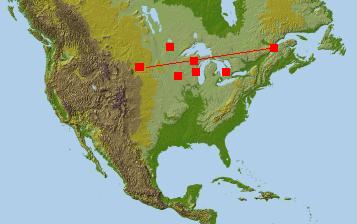
You received this Newsletter because you Subscribed
to the ZetaTalk Newsletter service. If undesired, you
can quickly Unsubscribe.
You can always access prior Newsletters from the Archives.
|

